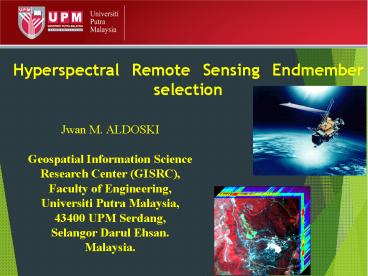Hyperspectral Remote Sensing Endmember selection - PowerPoint PPT Presentation
Title:
Hyperspectral Remote Sensing Endmember selection
Description:
Hyperspectral Remote Sensing Endmember selection – PowerPoint PPT presentation
Number of Views:144
Title: Hyperspectral Remote Sensing Endmember selection
1
Hyperspectral Remote Sensing Endmember
selection
Jwan M. ALDOSKI Geospatial Information Science
Research Center (GISRC), Faculty of Engineering,
Universiti Putra Malaysia, 43400 UPM Serdang,
Selangor Darul Ehsan. Malaysia.
2
Overview
- What is an endmember
- How to select image endmembers by
- Manual picking from image
- Manual picking from library spectra
- Analysis of purest image pixels using MNF
transform and PPI images
3
Definition
- A spectral endmember is
- The average spectral signature of a pure surface
cover type in the image. - Represents a class that we want to spectrally
classify or identify in an image - Can be in itself a mixture that do not can/want
to further separate (e.g. an individual soil
class)
4
Endmembers and mixtures
- Most pixels are mixed
- A few pixels are pure
- 2 Endmember spectra and 1 mixed spectrum
Sources rst.gsfc.nasa.gov/Sect13/Sect13_2.html ww
w.cis.rit.edu/research/thesis/bs/1999/newland/thes
is.html
5
Endmembers and mixtures (contd)
- Mixtures of three (triangle) and two (line)
endmembers in 2-d feature space
6
Content
- What is an endmember
- How to select image endmembers by
- Manual picking from image
- Manual picking from library spectra
- Analysis of purest image pixels using MNF
transform and PPI images
7
Endmember selection
- Manual picking from image data
- Assumption of homogeneity
- Some endmembers may be missed
- Manual picking from existing library spectra
- Requires knowledge of ground composition
- Library spectra may differ from image spectra
- Analysis of purest image pixels using MNF
transform and PPI images - Output endmembers may not make geologic sense
8
Endmember selection
- picking from image
9
Endmember selection
- picking from library spectra
10
End to end mapping solution
11
MNF assumptions
1. image noise is weakly autocorrelated compared
to the autocorrelation of the image
signal 2. correlation between pixels yield
information for MNF rotation referred to as
MAF min/max autocorrelation factors (noise
would yield a flat variogram no spatial
correlation) Results of MNF forward - ordering
of signal and noise in transformed bands - user
can interactively decide which factors are used
for reversed transformation. Noise for MNF can
be estimated from - dark current image - dark
parts of the image (lake, shade) - image itself
12
MNF approach
Eigen values estimated from
Dark current image Normal image section Low
correlation of spectral bands High correlation of
image bands Low data redundancy Data redundancy
13
Results PCA transform on hyper spectral
image poor ordering of image quality
GERIS-image
14
Results MNF transform on hyper spectral image
improved ordering of image information and noise
GERIS-image
15
The pixel purity image
Endmembers have to be pure and can be selected
directly from a spectral library or from the
scene using PCA techniques.
PCA for 2 or 3 endmembers
The PPI image shows areas that are
statistically more spectrally pure and thus
represent endmembers at the vertices of the
cluster of points in the feature space.
16
Endmember picking
17
The exercise
- The exercise endmember selection guides you
through the process of selecting image endmembers
for further spectral matching and image analysis.
18
Sources
- http//rst.gsfc.nasa.gov/Sect13/Sect13_2.html
- http//www.cis.rit.edu/research/thesis/bs/1999/new
land/thesis.html - Personal materials from
- ENVI tutorial
- Steven de Jong
19
Thank you































